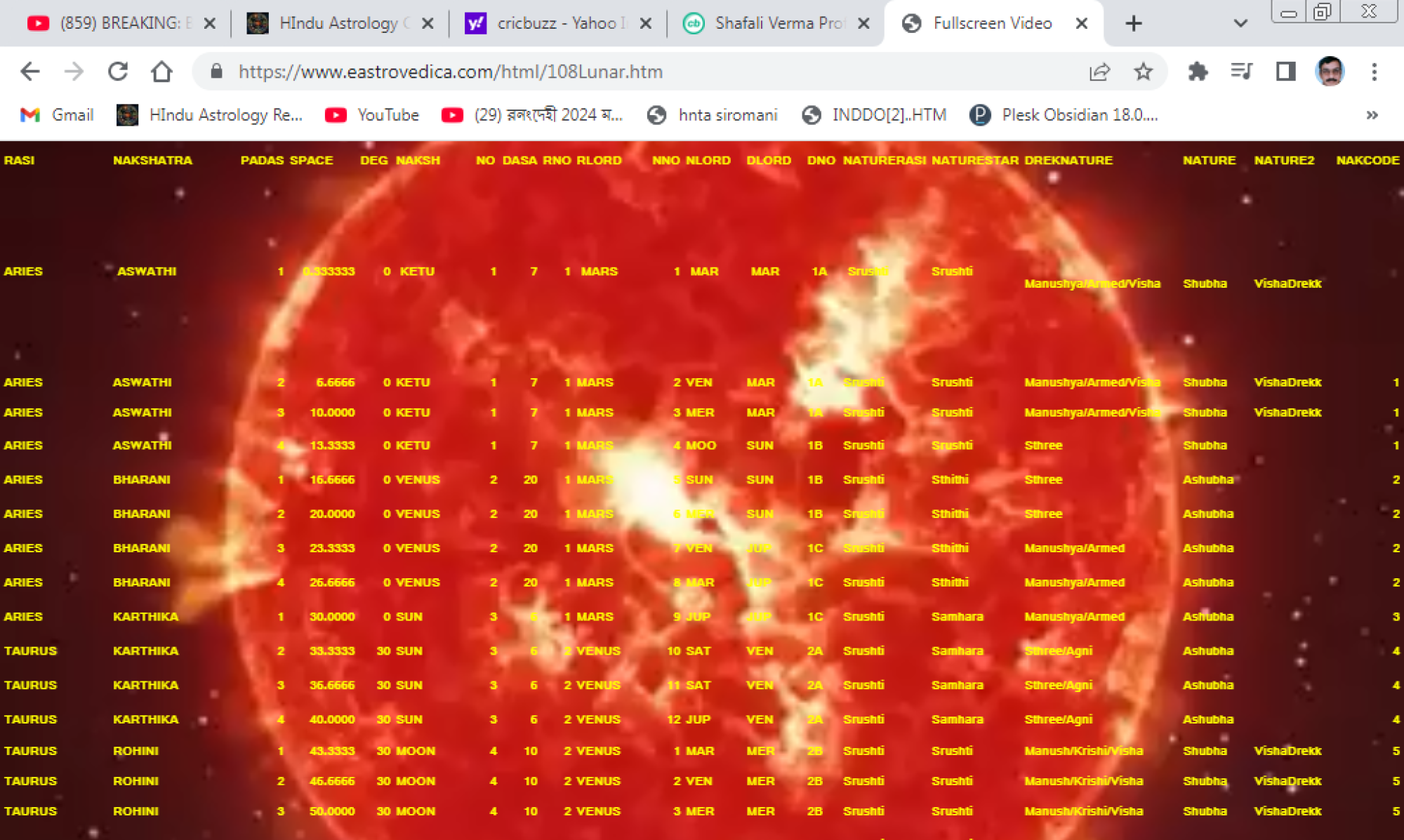Keralites happy as it is proximate to Kerala !
T H E H O R A T A B L E
Start Sun, Mon Tue, Wed, Thu, Fri Sat End
605 SUN MOO MAR MER JUP VEN SAT 705
705 VEN SAT SUN MO0 MAR MER JUP 805
805 MER JUP VEN SAT SUN MOO MAR 905
905 MOO MAR MER JUP VEN SAT SUN 1005
1005 SAT SUN MOO MAR NER JUP VEN 1105
1105 JUP VEN SAT SUN MOO MAR MER 1205
1205 MAR MER JUP VEN SAT SUN MOO 1305
1305 SUN MOO MAR MER JUP VEN SAT 1405
1405 VEN SAT SUN MO0 MAR MER JUP 1505
1505 MER JUP VEN SAT SUN MOO MAR 1605
1605 MOO MAR MER JUP VEN SAT SUN 1705
1705 SAT SUN MOO MAR NER JUP VEN 1805
1805 JUP VEN SAT SUN MOO MAR MER 1905
1905 MAR MER JUP VEN SAT SUN MOO 2005
2005 SUN MOO MAR MER JUP VEN SAT 2105
2105 VEN SAT SUN MO0 MAR MER JUP 2205
2205 MER JUP VEN SAT SUN MOO MAR 2305
2305 MOO MAR MER JUP VEN SAT SUN 2405
2405 SAT SUN MOO MAR NER JUP VEN 2505
2505 JUP VEN SAT SUN MOO MAR MER 2605
2605 MAR MER JUP VEN SAT SUN MOO 2705
2705 SUN MOO MAR MER JUP VEN SAT 2805
2805 VEN SAT SUN MO0 MAR MER JUP 2905
2905 MER JUP VEN SAT SUN MOO MAR 3005Program Code for Computing Planetary Hours, Kala Hora
close databases
close all
use kdxx
zap
use ppx
store srise to rise
store dow(date()) to vno
store cdow(date()) to vr
store recno() to reno
use vara
locate for no = vno
store lord to pl
use hd
locate for lord = pl
store lord to ld2
store recno() to re
use kdxx
append blank
repl lord with ld2
repl no with 1
repl start with rise
repl day with vr
use hd
go re+1
store lord to ld3
use kdxx
append blank
repl lord with ld3
repl no with 2
repl start with rise+100
repl day with vruse hd
go re+2
store lord to ld4
use kdxx
append blank
repl lord with ld4
repl no with 3
repl start with rise+200
repl day with vr
use hd
go re+3
store lord to ld5
use kdxx
append blank
repl lord with ld5
repl no with 4
repl start with rise+300
use hd
go re+4
store lord to ld6
use kdxx
append blank
repl lord with ld6
repl no with 5
repl start with rise+400
use hd
go re+5
store lord to ld7
use kdxx
append blank
repl lord with ld7
repl no with 6
repl start with rise+500
repl day with vr
use hdgo re+6
store lord to ld
use kdxx
append blank
repl lord with ld
repl no with 7
repl start with rise+600
use hd
go re+7
store lord to ld
use kdxx
append blank
repl lord with ld
repl start with rise+700
use hd
go re+8
store lord to ld
use kdxx
append blank
repl lord with ld
repl start with rise+800
use hd
go re+9
store lord to ld
use kdxx
append blank
repl lord with ld
repl start with rise+900use kdxx
go top
store lord to lord1
store start to s1
store day to da1
skip
store lord to lord2
store start to s2
store day to da2
skip
store lord to lord3
store start to s3
store day to da3
skip
store lord to lord4
store start to s4
store day to da4
skip
store lord to lord5
store start to s5
store day to da6
skip
store lord to lord6
store start to s6
store day to da7
skip
store lord to lord7
store start to s7
store day to da5
skip
store lord to lord8
store start to s8
store day to da8
eastrovedica, hindu astrology software consultancy and research, computing vedic planetary positions By Govind Kumar
The Starting of the Epoch is 13/04/1899, the Karana Arambha. The sidereal positions of planets are given at the time of the Epoch ( at the Sunrise Time at Trivandrum, Kerala, India ). The computations are based on Vedic Astronomy ( Siddhanta ) & Vedic Mathematics.
The Sidereal Positions of planets
Planet Sign Degree Mins Secs Tatpara
Sun 11 28 33 50 44
Moon 0 29 40 21 1
Moon's Apogee 3 12 39 15 19
North Node 8 10 38 45 40
Mars 4 13 45 4 40
Mercury 5 11 38 31 41
Jupiter 6 13 47 42 7
Venus 8 19 49 11 32
Saturn 7 25 20 11 55
M = Mean Anomaly of the planet; A = Aphelion of the Planet ; L = Mean Longitude of the Planet; e = orbital eccentricity; mjv = orbital eccentricity in seconds; Sheegra Kendra = The Anomaly of Conjunction; Sheegroccha = Perihelion; Mandoccha = Aphelion; Sheeghra Phala = The Angle between the Planet, the Sun and Earth; Oja = Odd; Yugma = Even; Manda Kendra = The angle between position and Aphelion; Sheeghra Kendra Ardha = A/2, half of Sheegra Kendra; Kranti Vritta = Ecliptic; Vikshepa Vritta = Heliocentric Circle; Kshithija = Celestial Horizon; Bha Chakra = Zodiac; Vishuvat Vritta = Celestial Equator; Khagoleeya Dhruva Rekha = Celestial Meridien; Vishu Vat Bhoga = Right Ascension( R A ); Meshadi = The First Point of Aries; Thuladi = The First Point of Libra; Karkyadi = The First Point of Cancer; Makaradi = The First Point of Capricorn; Theta = True Longitude of the planet; v = True Anomaly; Manda Karna = Radius Vector, heliocentric distance; Sheeghra Karna = geocentric vector, distance of the planet from the earth; Ravi Manda Karna = Sun's distance; Nathamsa = Altitude of the Planet; Digamsa = Azimuth. Bhaga, Kala, Vikala = Deg, Mins, Secs; Madhyama Manda Karna = Average Vector; Patha = Node; Thidhi - D or Day or Lunar Day, the first Lunar Day being the Moon within 12 degrees of the Sun; Vara - Day of the Week; Bhujajya = R Sin; Kotijya = R Cos; Sparsajya = Tan; Sparsachapa= Atan; Bhujachapa = Asin; Kotichapa = Acos; Pranakalanthara= Difference between Tropical Longitudes and R A; Kala Hora = Planetary Hours; Hora = Hour; Chara Jya = Sin C; Manda Jya = Sin M; Parinathi Jya = Sin h; Guru Sani Karsha - Perturbations of Jupiter and Saturn; Chandra Karsha - Perturbations of the Moon; Chathurdasa Jya Samskaras - 14 trignometric corrections to the Moon; Vikshepa - Celestial Latitude; Kranti - Declination; Dhruva = R A ; Sphuta = Celestial Longitude; Indra - Uranus; Varuna = Neptune; Rudra = Pluto; Kala = Phobos; Mrityu = Deimos; Gulika = Titan; Yamakandaka = Ganymede; Vipatendu = Mean Longitude of the Moon - Node of the Moon ; Manda Karna - heliocentric distance; Sheegra Karna - geocentric distance of the planet, Parama Vikshepa/ Sara - the angular distance of the orbital plane from the Ecliptic Parama Manda Karna - Maximum Vector, Laghu Manda Karna - Minimum Vector ; Vipata Kendra - the angle between Position and the Node; Sheegra Kendra - the angle between Position of the planet and the Earth Sun Vector.
Sara - Reverse Sine, 1-cos x, Chapa - Arcsine. The Arcsine resembles a Bow,Chapa and Versine, Arrow, Sara, according to the Indian mathematicians !
The Three Methods of Vedic Astronomy & Mathematics
1) Zodiacal Longitudes - The First Method is to compute the longitudes of the planets along the Ecliptic ( Kranti Vritta ). Western astronomers have accepted 0 degree Aries as the First Point of the Tropical Zodiac and Vedic astronomers have accepted 0 degree Beta Arietis ( Aswini ) as the First Point of the Sidereal Zodiac. Extending 9 degrees to either side of the Ecliptic is the Great Circle of Light, the Zodiac.
2) Celestial Equatorial Longitudes - The Second Method is to compute the longitudes along the Celestial Equator ( Vishuvat Vritta ). The Starting Point is 0 degree Aries. The longitudes thus obtained is called the Right Ascension ( R A ) of Planets.
3)Celestial Horizontal Longitudes - The Third Method is to compute longitudes along the Celestial Horizon. The Eastern Celestial Horizon, the intersecting point between the Ecliptic and the Celestial Horizon, is called the Ascendant ( Udaya Lagna ). 180 degrees opposite to that point is called the Western Celestial Horizon ( Astha Lagna ). The highest point on the Celestial Horizon is called the Zenith ( Madhya Lagna or MC ) and the lowest point, the Nadir ( Patala Lagna or IC ). The Original Point of the Celestial Horizon is the Northern Point on the Celestial Horizon.
The Vedic Method is Longitude corrected thrice, through 3 major trignometric corrections called
Manda Kriya ( Reduction to True Anomaly )
Parinathi Kriya ( Reduction to Ecliptic )
& Sheeghra Kriya ( Reduction to Geocentric Coordinates ).
Reduction to the Heliocentric Coordinate System
I . Reduction to True Anomaly ( Manda Kriya )
After finding the Mean Longitude of the Planet, the Mean Anomaly of the Planet is calculated as per the formula
Mean Anomaly = Mean Longitude - Aphelion ( M = L - A ).
The Manda Jya Vikalakal ( mjv , eccentricity in seconds ) is computed as per the formula
mjv = R (2 e - 1/4 e^3 + 5/95 e^5 ) Sin A + R (5/4 e^2 - 11/24 e^2 + 17/192 e^2 ) Sin 2 A + R ( 13/12 e^3 - 43/64 e^5 ) Sin 3 A + R ( 103/ 96 e^4 - 451 / 480 e ^5 ) Sin 4 A + R ( 1097/960 e ^5 ) Sin 5 A + R (1223/960 e ^ 6 ) Sin 6 A
A = Mean Anomaly of the Planet + 6 Signs or M + 180. R is 206265 seconds
This value MJV is deducted or added to M, the Mean Anomaly of the Planet to get the True Anomaly of the planet, v
v = M + or - mjv
If the Mean Anomaly ( Manda Kendra ) is greater than 6 Signs, it is added and if it is less than 6 Signs ( 180 degrees ), it is subtracted.
The Radius Vector ( Manda Karna ) is computed using the formula
Manda Karna = a ( 1+ 1/2 e^2 ) - e ( 1- 3/8 e^2) Cos A - 1/2 e^2 ( 1- 2/3 e^2 ) Cos 2 A - 3/8 e^3 Cos 3 A - 1/3 e^4 Cos 4 A )
where a is the semi major axis ( Madhyama Manda Karna ) of the planet. Semi Major Axis is the average distance of the planet expressed in AU. The Sun's a is 1 AU or 149 million kilometres from the earth. It is to be noted that at 90 degrees the Manda Karna of the planet equals Semi Major Axis because Cos 90 = 0.
Reduction to the Ecliptic Coordinate System
II. Reduction to the Ecliptic ( Parinathi Kriya )
The Ascending Node of the planet is deducted to get the Y, the planet minus the Node.
Y = True Anomaly of the Planet - Node of the planet
First the latitude of the planet is computed as per the formula
Sin l = Sin L Sin Y
where l is the latitude of the planet, Y is the Longitude of the planet after deducting the Node and L is the maximum latitude of the planet
The mean longitude of the planet after Manda Kriya is reduced to the Ecliptic Coordinate System . The formula used is
Sin h = ( 1-Cos L Sin Y Cos Y /cos l )
where the l is the latitude of the planet, Y is the Longitude of the planet after deducting the Node and L is the maximum latitude of the planet and h is the Parinathi Phalam, the factor which is to be added or subtracted to the True Anomaly. ( This is also the formula used for computing the Sun's Pranakalanthara which is the difference between Tropical longitudes and Right Ascension ).
i or Inclination or inclinent of Orbit, is known as Parama Vikshepa, the angular distance of the orbital plane from our plane of reference, the Ecliptic. This is also known as Sara. For Mercury, it is 7 degrees and for Jove it is 1.31 degrees.
The first 3 Signs are Odd ( Oja ), the next 3 Signs are Even ( Yugma ), the next 3 Signs are Odd ( Oja ) and the next 3 signs are Even ( Yugma ).
The Parinathi Phalam is added if the Signs are Yugma and subtracted if it is Oja to True Anomaly to get the Ecliptic degree.
Ecliptic Degree = True Anomaly + or - Parinathi Phalam
The Heliocentric distance or Manda Karna ( Kranthi Vritheeya Manda Karna ) is computed as per the formula
Kranthi Vritheeya Manda Karna = Vikshepa Vritheeya Manda Karna * cos l
Reduction to the Geocentric Coordinate System
III Sheeghra Kriya - Reduction to Geocentric Coordinates
The Sheeghra Anomaly
When the longitude of the Sun is deducted from the Ecliptic Degree thus obtained, we get the Sheeghra Anomaly, the angle between the Sun and the planet
Sheeghra Anomaly = Heliocentric longitude of planet - Longitude of the Mean Sun.
x, Sheeghra Phalam is the angle formed between the Sun, the planet and the Earth. It is computed as per the formula
Tan A/2 - x = ( b - a) /( b + a) Tan A/2
where A is the Sheeghra Kendra, a is the Ravi Manda Karna ( Sun's distance ), b the Graha Manda Karna ( distance of the planet from the Sun ) and x the Sheeghra Phalam
Arka Sphutoniham Kheda Mandasphuta mihoditham
Sparsajya Sheegrakendrardha Labhda karnathara hatha
Karna Yoga hritha bhooya sparsa chapatmaka kritha
Shoditha sheegrakendrardhal syath phalam sheegrasamjnakam
The Sheeghra Phalam is added if the Signs are greater than 6 and subtracted if the Signs are less than 6 .
There is another method of computing Sheeghra Karna, the geocentric distance of the planet. . Sheeghra Karna can be computed by the following formula
c^2 = a^2 +b ^2 + 2 a b Cos A and the Sheegra Phalam can be obtained by
sin x = a Sin A /c for Jupiter, Mars and Saturn &
sin x = b Sin A /c for Mercury and Venus
True Longitude of the Planet = Heliocentric Longitude of the Planet - or + Sheegra Phalam.
If the Mandaphalam is m and p is Parinathi Phalam and s is Sheegra Phalam, then
Truelong = Meanlong + or - m + or - p + or - s
For Mercury and Venus, the computation is slightly different. The Sheeghra Phalam thus obtained is subtracted from the Sun's longitude if the Signs are more than 6 and added if the Signs are less than 6.
This method of Longitudes Corrected Thrice is highlighted in Puliyoor's Ganitha Nirnaya and Bhaskara's Ganitha Adhyaya. Achyuta Pisharody's Sphuta Nirnaya also deals with the calculations in Indian Astronomy. Other reference books are Maha Bhaskareeya, Aryabhateeya and Brahma Sphuta Siddhanta.
In Mathematics there are many methods and the Western Method is to find the True Anomaly of the Planet and to it add the Argument of Perihelion ( Long = v + w ). The Eccentric Anomaly of the Planet ( an auxiliary angle used in Kepler's equations ) is computed from the Mean Anomaly and the True Anomaly is computed from it . The Argument of Perihelion is added to it to get the true longitude. v is the Angle between the Planet and Perihelion and w is the angle between the Node and Perihelion. The perturbations of the Moon, Jupiter and Saturn are included in these computations. Some large perturbations of the Moon, viz the Evection, the Annual Equation, the Variation and the Parallactic Equation, with the equations of the Center, are all included. While the Western Method is to give 12 corrections to the Moon's longitude, the Vedic method is to subject the Mean longitude of the Moon to 16 trignometric corrections. ( 14 reductions plus Manda Kriya & Parinathi Kriya ).
Then find out the Cartesian coordinates, x,y and z and then convert it to Spherical Coordinates, r, Theta and Phi. This Western method is not at all similar to the Indian one.
In essence, the Vedic Mathematical Method is to subject the Mean Longitude of the Planet to three major trignometric reductions. Also the other planets. Our friend Paul Schylter has done a great work in computing the Planetary Positions as per the Western System. Our congratulations to him. Here we give the Vedic Method as expounded by Aryabhata, Bhaskara, Brahmagupta, Madhava, Jyesthtadeva, Parameswara and countless other Vedic astronomers in the 18 Siddhantas ( treatises on Astronomy), written 5000 years ago !
Karthika, the Seven Wives ( Pleaides, the Seven Sisters )
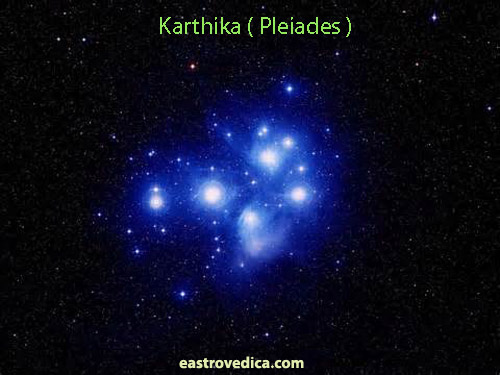
See the Diamonds in Blue. Glorious lights in a blue background. The Full Moon occurs there during the lunar month of Karthika and we call this Festival of Lights, Deepawali !
The constellation of Karthika are the Pleiades, the Seven Sisters in the Western. In the Indian they are the seven wives of the Seven Sages or Sapta Rishies !
Their names in the Indian
Husband Wife
| Marichi | Kala |
| Atri | Anasuya |
| Vasishta | Arundhathi |
| Angiras | Shraddha |
| Pulaha | Havubhuh |
| Pulastya | Gathih |
| Krathu | Kriya |
They are also the Seven Sisters of Kapila. Born to Kardama and Devahooti, they are the sisters of the Divine Incarnation, Kapila, who propounded the Natural Philosophy of Sankhya ! Incidentally, Kapila had two more sisters – Fame ( Khyathi ) and Peace ( Shanti ) !
Their names in the Western
Maia
Electra
Taygete
Alcyone
Caleano
Sterope
Merope
Astronomic Symbolism of the Pleiades or Karthika

In Western Mythology, the Seven Sisters were loved by Orion, the Hunter. At their behest, Jupiter converted them into doves and placed them in the heavens. In the Indian, they are the wives of the Seven Rishies. Arundhathi or Alcyone is the central Star. There is a theory in Astronomy that our Sun is revolving around Alcyone, the Grand Central Sun !
Mythologically, Lord Karthikeya was born to Agni and Svaha, who impersonated the six stars of the Pleiades constellation or Karthika. Hence the name Karthikeya. While Arundhati remained devoted to Vasishta, the other six Rishies divorced their wives. Karthikeya was brought up by the Six Sisters, which became Karthika, while Alcor ( Arundhati ) remained close to Vasishta ( Mizar ).
Scientific truths are contained in Mythology, averred Bacon, in his De Sapientia Vaterum.

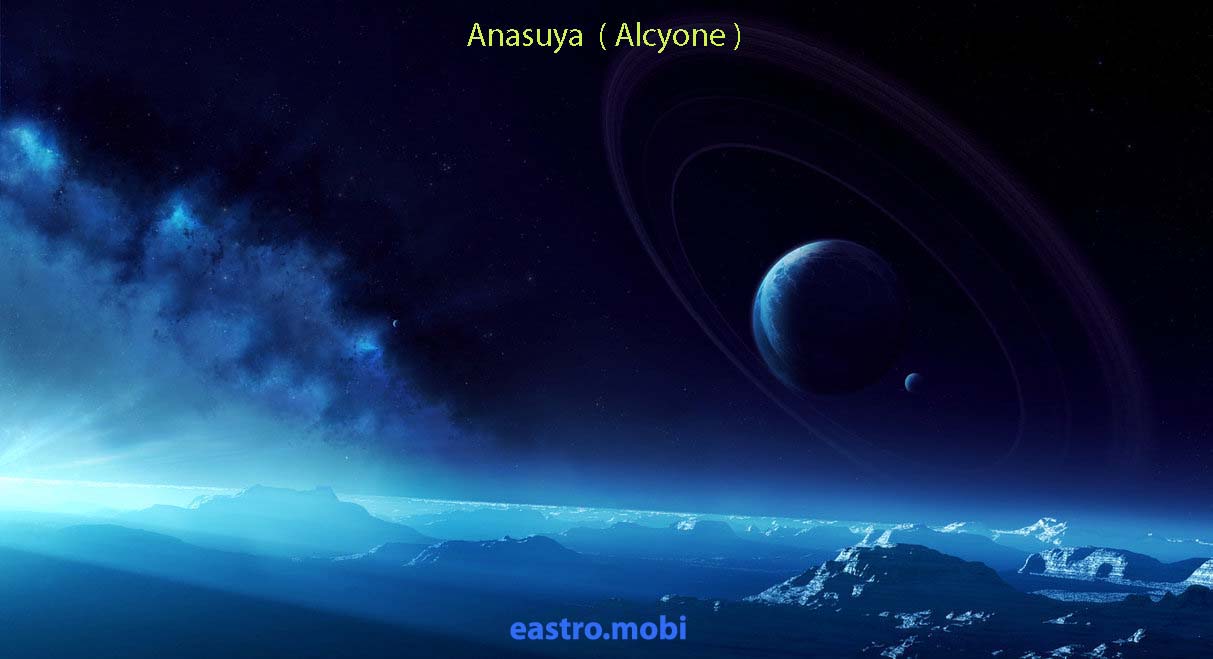
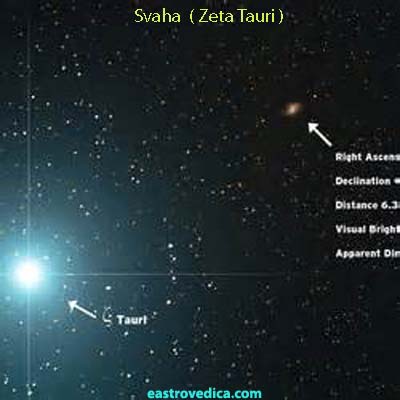
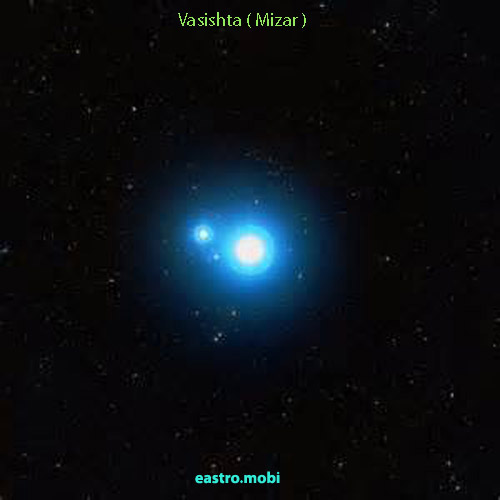
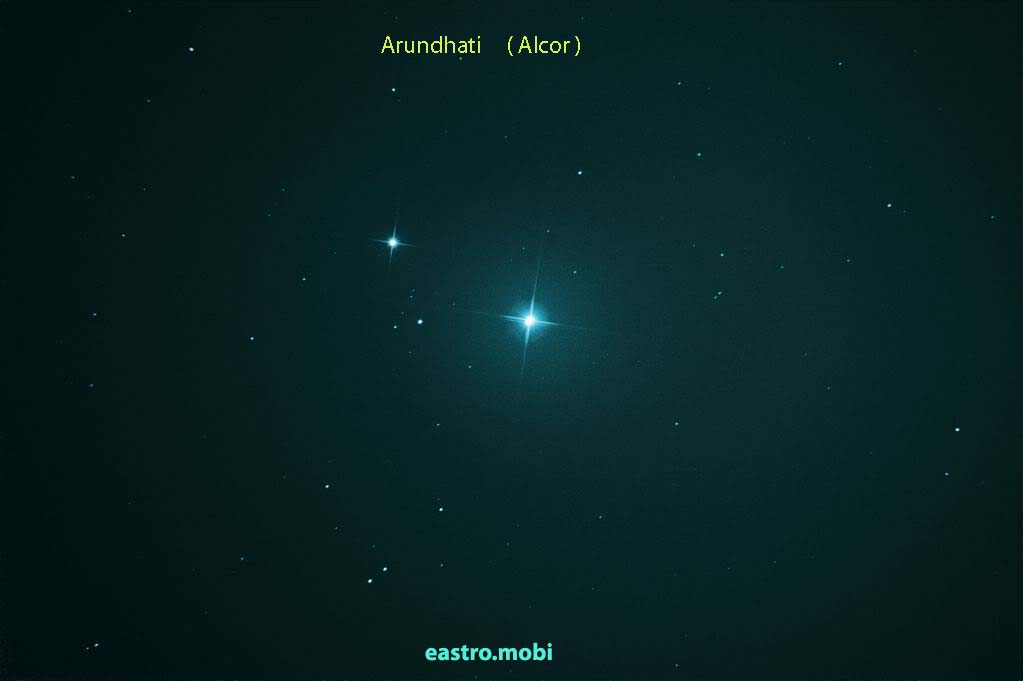
Karthika Njattuvela
When the Sun transits the constellation of Karthika ( from May 11th onwards ), Kerala gets relief from extreme heat ( as it lies 10.30 North of the Equator ) from the months of Sidereal Aquarius and Pisces, Kumbham and Meenam and the parched earth begins to get rainfall. Rain accelerates during the Sun’s transit of Rohini ( Aldebaran, from May 25th onwards ) and then from Mriga Sira Njattuvela ( solar transit of Meissa ) onwards ( from June 8 ), Kerala gets tremendous rains !

The Seven Rishies ( Ursa Major )
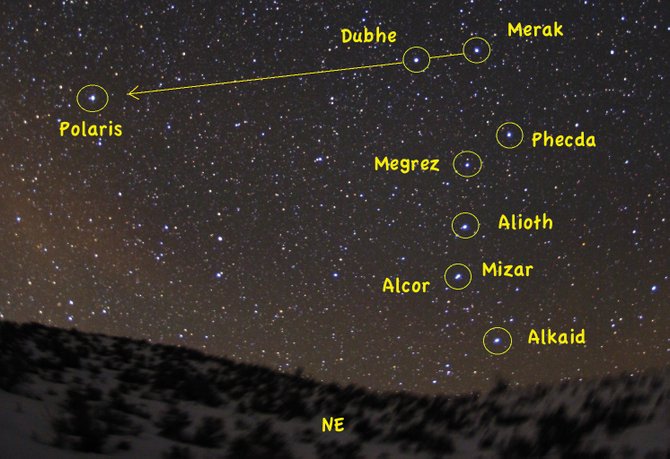
It is the custom in all Hindu marriages, to show the stars Vasishta and Arundhati to the married couple. Vasishta and Arundhati, both mythological figures, are actually stars in the heavens ! Their harmony and devotion to each other was worthy of emulation and admiration. This tradition is now becoming extinct and here we will describe the Seven Rishies.
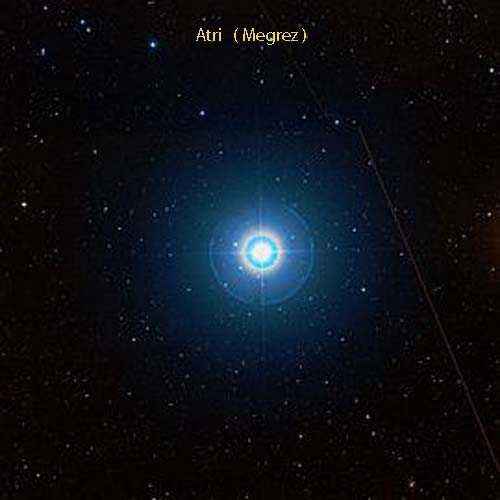

This pair is in the constellation of the Big Dipper or Ursa Major. Ursa in Latin means Bear . This constellation is known as Sapta Rishi Mandala. There is also another constellation called Ursa Minor.
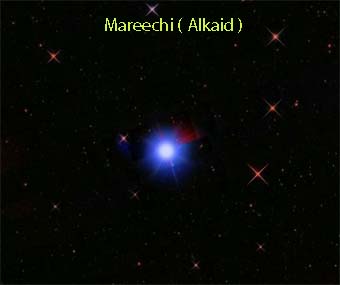
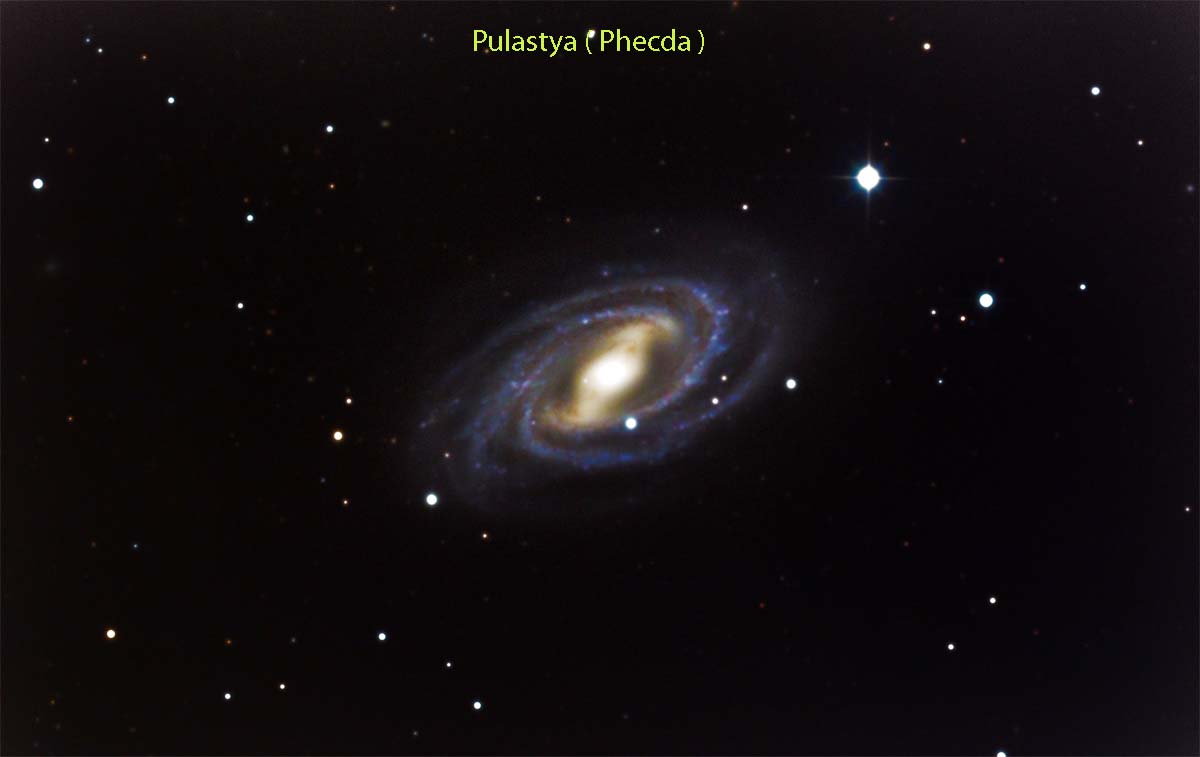
In his Brihat Samhita, Varaha Mihira ( 550 BCE ), gives clear defintions about them. His postulates are as follows :
In the Sky North, we have the Saptha Rishies revolving around Dhruva ( Polaris ) like a necklace, according to Garga.
From East to West, the Seven Rishies, Atri, Angiras, Marichi, Pulastya, Pulaha, Kratu and Vasishta stay. Chaste Arundhati accompanies Vasishta.
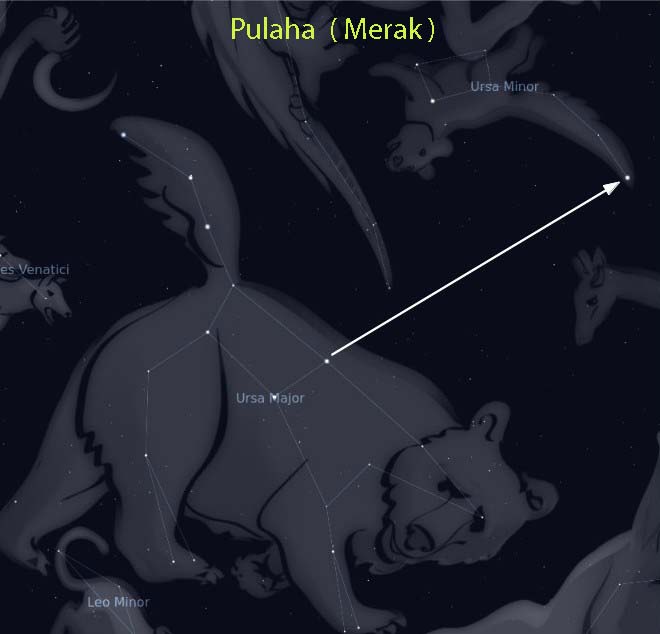
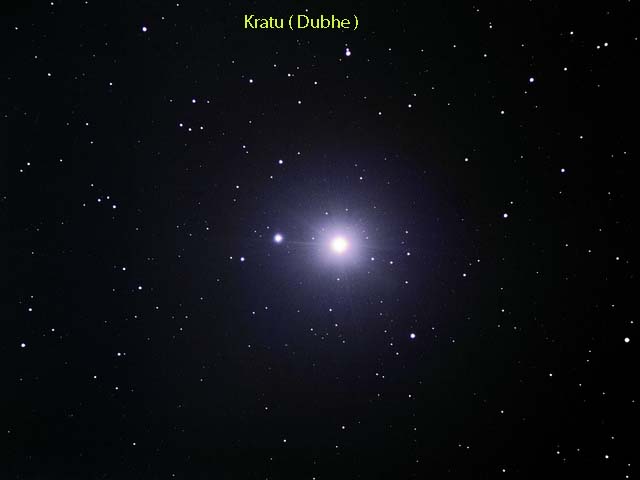
At the time of death, however, one will not be able to see both Mizar and Alcor, that is Vasishta and Arundhati.
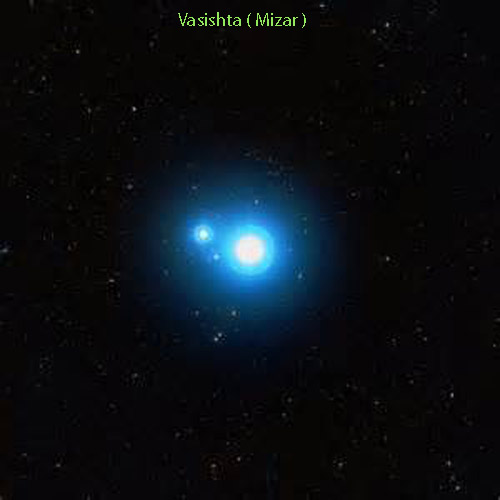
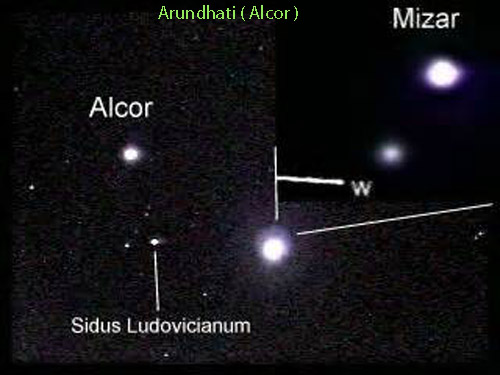
Ursa Major Cycle, Sapta Rishi Yuga
Professor Drayson wrote in ” Asiatic Researches “
The Hindus thought proper to connect their Mythology with an astronomical period of a strange nature. It is that of the Seven Rishies, moving along the Zodiac in a retrograde motion in 2700 years.
They stay in a constellation for 100 years. Hence an Ursa Major Cycle = 27*100 = 2700 years.
They were in Regulus, Makha, at the start of the Maha Bharata War !
The first Astronomical Calendar was erected by the Vedic Emperor, Vaivashvata Manu in circa 8736 BCE !
Their Wives are the Pleiades or Karthika. Anasuya ( Alcyone ) is the main star, along with Arundati ( Alcor ) and five more stars !
Wheeler Wilcox wrote ” India – the Land of the Vedas, the remarkable work contain not only religious ideas for a perfect life, but also facts which science has proved true. Electricity, radium, electronics, airplane, all were known to the Seers who founded the Vedas ! “



https://www.youtube.com/embed/hepzUgFhgis https://www.youtube.com/embed/n_gT9nBfhfo https://www.youtube.com/embed/KliBRinZHJA?rel=0 https://www.youtube.com/embed/PscaILei3vs?rel=0


